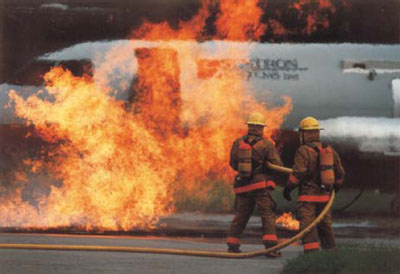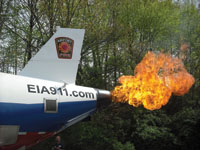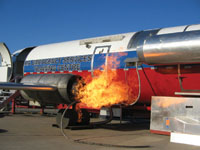
Headlines
News
Hands-on training
On Aug. 2, 2005, Air France Flight 358 was inbound to Lester B. Pearson International Airport in Toronto from Paris with 12 crew and 297 passengers. Thunderstorms near the airport drenched the runways and created strong winds that changed direction erratically.
November 16, 2009
By Blair Watson
On Aug. 2, 2005, Air France Flight 358 was inbound to Lester B. Pearson International Airport in Toronto from Paris with 12 crew and 297 passengers. Thunderstorms near the airport drenched the runways and created strong winds that changed direction erratically. As the first officer attempted to land, a sudden tailwind pushed the four-engine jetliner along the 9,000-foot runway before its main landing gear tires made contact – with just 5,000 feet remaining.
 |
| Edmonton’s Kidde MA-3000 mobile aircraft fire trainer allows crews to do multiple drills in a day and can be transported to other airports. Photo courtesy Edmonton International Airport |
The combination of poor visibility in heavy rain, the initial landing manoeuvre – the flare started 50 feet too high – the sudden tailwind, significantly reduced tire friction because of standing water on the runway and a delay in activating reverse thrust resulted in the Airbus A340 failing to stop before the hard landing surface became soaked dirt and grass. The 185-tonne airplane crashed through the airport fence to the west of runway 24L (left) and into a ravine. Fires erupted outside the cabin as the aircraft came to a stop. In less than one minute, airport firefighters reached the crash site and began combating the blaze. By the time the flames were extinguished, most of the aircraft had been obliterated. Incredibly, all 309 occupants fled the burning airliner and survived.
The accident at Toronto’s main airport underscored the need for regular and realistic training for firefighters who respond to aircraft crashes, aviation fuel spills and other situations involving fire or the possibility of ignition. In addition to Toronto International Airport, there are 25 major and regional airports in Canada as well as hundreds of smaller airports serving communities across the country. Although the larger airports have on-site aircraft rescue and fire fighting (ARFF) resources, the smaller aerodromes rely on municipal firefighters and equipment in the event of a fire at the airport or nearby.
Canada’s fifth-largest airport in terms of passengers is the Edmonton International Airport. In July, the airport authority took possession of a mobile aircraft fire trainer (MAFT), the first of its kind in Canada and one of a few in the world. Other jurisdictions that use the Kidde MA-3000 aircraft fire simulator are the American states of Virginia and West Virginia, and Germany. The Virginia Department of Fire Programs was particularly helpful in providing input to the Edmonton MAFT project team – led by training officer Corey Schram – based on its MAFT experience.
Schram has been involved with fire fighting and training for decades. In 1985 he joined the Spruce Grove Fire Department in Alberta and progressed through the ranks to become training officer and captain. Eleven years later he started working as a fire service instructor at the Emergency Training Centre (ETC) in Vermilion, Alta., – 220 kilometres east of the international airport – where he planned and delivered training to career and volunteer firefighters, fire inspectors, investigators, officers, safety educators, instructors and fire code officers. In 2003, he accepted the Edmonton training officer position, and for the past six years has been responsible for the development, delivery and monitoring of ARFF training programs.
 |
|
| The fuselage of the MAFT is is the size of a large commuter aircraft; the detachable wing can be attached to the fuselage at the low, mid or high position to simulate different types of airplanes. Photo courtesy Edmonton International Airport |
Part of Schram’s work over the summer was to certify the MA-3000 simulator for operation after its arrival in Edmonton. MAFT certification was the culmination of two years of effort. In the past, firefighters at the Edmonton International Airport used a square sea container that resembled an airplane fuselage; firefighters explained how they would deal with a fire situation without actually demonstrating what they would do. More realistic, hands-on training was clearly needed.
Schram and his team considered building a fixed fire training facility but the cost was high and firefighters from other airports in the Edmonton area or beyond would have to come to the facility for live fire training. The cost of sending Edmonton firefighters to the ETC in Vermilion was also substantial. The committee tasked with examining live fire simulators realized that a mobile system would address a number of issues at the four metro Edmonton airports and other airports in Alberta.
The ability to transport the MAFT to any location where live fire training is needed – and authorized to take place – is a big advantage. With the MA-3000 system, firefighters can use their own equipment during training and conduct more than one live fire drill a day. Fire departments in Edmonton and other Alberta communities benefit financially because they can have the mobile simulator brought to them instead of having to send their firefighters away for training. Furthermore, the airport authority is able to recoup its investment by providing live fire training services. Also, the MAFT is better for the environment than other training systems because it burns propane, not jet fuel or aviation gasoline, and its fires are put out with water, not foam.
After researching aircraft fire trainers, visiting departments that employed fixed or mobile training systems, taking into account the environmental effects of live fire training, and creating a business case to justify the purchase of the MA-3000 simulator, the MAFT committee recommended to management that the airport authority buy the American system.
Edmonton airport’s MA-3000 simulator was designed and built by Kidde Fire Trainers of Montvale, N.J. The system – approved for ARFF training by the Federal Aviation Administration in the U.S. and Transport Canada – is self-contained and transportable by trucks. It incorporates many of the features of a fixed trainer without the need for costly and immobile infrastructure. The MAFT consists of four main elements:
- An aircraft fuselage with a detachable wing (and a simulated jet engine), movable main landing gear assembly and auxiliary power unit (APU) in the aft part of the fuselage (the APU runs on jet fuel and generates electrical power on the ground when the main engines are not running). The fuselage is also equipped with piping for simulated cabin fires and cut-in panels so that firefighters have to “force” their entry, just as they might after an aircraft crash.
- Burn pans used to simulate ignited aviation fuel spills.
- A propane supply and storage system.
- A control station with a computer that permits the training officer to initiate or terminate a fire in any part of the MAFT.
The fuselage is the size of a large commuter aircraft such as the popular Bombardier CRJ (Canadair regional jet) operated by Air Canada and other airlines. The detachable wing can be attached to the fuselage at the low, mid or high position to simulate different types of airplanes.
 |
|
| Edmonton’s MA-3000 simulator is self-contained and transportable by trucks.
|
Inside the simulator fuselage is a cockpit, a passenger area with seats, a galley and a bathroom. As in real aircraft, fuel and battery shut-off controls are in the cockpit. The main cabin has a flashover feature and can be filled with smoke. Speakers add realism to the training; audio effects include crackling flames and people crying out for help. Electrical fires from food and beverage equipment in the galley can also be simulated. Powered hotplates on magnets can be positioned anywhere in the MAFT and are used to create hotspots. Part of ARFF training involves a hand-held thermal imaging camera that transmits what it sees to the control station.
During training exercises, an instructor inside the MAFT monitors how firefighters respond to a fire scenario and new problems that suddenly appear (each is activated from the control station). An instructor watches outside the MAFT and another is in the control station. They each wear a control pendant that will shut down the fire(s) when pressed. Also, instructors are in radio communication with each other and the firefighters doing the training exercise.
To become an airport firefighter, candidates must first satisfy NFPA 1001: Firefighter II Professional Qualifications in order to be certified to NFPA 1003: Standard for Airport Fire Fighter Professional Qualifications, 2005 Edition, Part III, Subpart 3: Aircraft Rescue and Fire Fighting at Airports and Aerodromes of the Canadian Aviation Regulations (CARs), details the relevant ARFF regulations. Anyone interested in learning more about ARFF can visit Transport Canada’s civil aviation website, which has information about airport firefighter qualifications, knowledge and skills training, recurrent training, command and control training and more.
While the CARs stipulate that airport firefighters must satisfactorily complete a live fire drill every 12 months, more frequent training helps to keep their skills sharp. Aviation is a highly regulated industry with an excellent safety record, so airport firefighters might not experience an actual aircraft fire during their entire careers. The current aircraft accident rate is 5.7 accidents per 100,000 flying hours; flying activity in Canada in 2008 was estimated at 4.4 million hours.
The Kidde mobile aircraft fire trainer allows airport and municipal firefighters to practise several fire scenarios, including an aircraft being engulfed in flames, as happened to Air France Flight 358.
Print this page